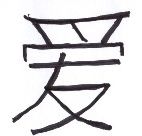It is easy to be English-centric when we think about learning to read. Most of our knowledge about learning to read has focused on English-speaking children. Most reading researchers speak English. What is hard for children learning to read English is probably hard for children everywhere, right? Possibly not. Over the past few decades, we have learned a lot more than we used to know about what it takes to learn to read in languages other than English.
Just how different is it for children learning to read in a language that is not English? It may depend partly on the characteristics of the writing system that the language is written in. A writing system is a way of visually communicating spoken language. Not all writing systems use similar means to communicate.
There are three basic kinds of writing systems: alphabetic, syllabic, and logographic. English, obviously, uses an alphabetic system, where the letters more-or-less correspond to individual sounds of the language. Syllabaries use the syllable as the operative unit of analysis, instead of single or blended speech sounds. Written Alaskan Yup’ik and Cherokee are examples of this; the “letters” in these languages represent syllables, and they go well beyond the Latin alphabet English readers are familiar with. Syllabaries still communicate something about what a word sounds like, though. For example, here is a Cherokee letter , that stands for a syllable in that language and its pronunciation (pronounced “ha”, as in “haha!” approximately):
Logographic systems are quite different from either syllabaries or alphabetic systems. Most of us are vaguely familiar with the look and feel of one logographic writing system, Chinese, thanks to the ubiquity of restaurant menus and the like. Chinese has probably the most utilized logographic system in existence. Here is the word love in Chinese (pronounced “ai”, as in “eye” approximately):

The distinction between these systems can be described as the difference between writing what you say versus writing what you mean (Ellis, Natsume, Stavropoulou, Hoxhallari, van Daal, Polyzoe, et al., 2004). That is, when writing in English, we (more-or-less) write down how to pronounce the words we want communicate, not as directly as in other languages such as Spanish, Italian, German, or Dutch, perhaps, but we basically write down what we hear and say. The same goes for syllabaries. Letters and letter patterns are symbols for the sounds of what we hear when we speak.
Logographic writing systems take a more direct tack in communicating the message within the writing system. In a logographic system, a symbol is used to represent an entire word. In Chinese, a single unit of writing (called a character) represents a given unit of meaning (more or less), rather than a certain sound. In this system, a child cannot guess how to pronounce a character just by looking at the parts of it, although there may be phonetic hints embedded in modern Chinese. The benefit of these logographic systems, however, is that they are transportable across dialects and different languages that adopt the system. For example, Japanese readers can get the gist of Chinese texts when reading using their Chinese-based kanji system. This allows Chinese knowledge and ideas to travel more easily to other neighboring cultures that have adopted their system of writing, even if their spoken languages are very different.
What implications does any of this have for children learning to read? For one, it takes years for Chinese-speaking children to learn to read and write --- there are 3,500-4,000 commonly used characters, and these are combined to form around 60,000 words (DeFrancis, 1986). New ones are introduced in every school year. There are simply just too many to learn in a single year or two. The U.S. Department of State estimates that it may take even a well-motivated adult businessman approximately 2,200 classroom hours to establish basic proficiency in reading Chinese!
Compare this to the mere matter of a few months it might take a child to learn all the 21 letter-sound relationships for Finnish. Finnish-reading children (as well as Albanian, Welsh, German, Italian, Spanish, and Dutch children) read texts fluently at an earlier age because there is comparatively little to learn. The mistakes Finnish children make when learning to read tend to be sound-based. Children learning to read in these languages are highly attuned to the need to attend to sound. Because there is a one-to-one correspondence between the letters and their sounds, learning to spell in these languages is a snap! Moreover, a well-motivated businessman might take a mere 600 hours to establish basic reading proficiency in Finnish or Spanish. It won’t take our business person very long to learn to pronounce words, so he or she will spend most of the time figuring out what all those words actually mean.
English-reading children are not quite as lucky as Spanish and Finnish children because their texts are not quite as cooperative. They have to learn both letters and groups of letters such as [th], [ch], [tion] and so forth. In part because English derives from several different root languages, the English writing system simply is not as transparent as it might be. Children learning to read English often just call up an entirely wrong word while reading aloud --- why? Because they have a whole confusing list of words that they’ve learned by sight --- and they just retrieve the wrong one. They confuse there for that, what for when, etc. It takes English-reading children several years to read fluently and even longer to learn to spell well. As we all know, even well-educated English adults misspell. A lot of classroom time is spent accomplishing what Spanish, Italian, and Finnish children accomplish in the smaller part of a year.
The strength of the underlying language skills that children need for learning to read will also differ depending on the language they will be reading in. For Chinese-reading children, it is important to have skills like compounding (such as found in English words like sunrise) because so many Chinese characters combine two or more meanings. Having a good understanding of the sound system of language is useful in learning to read Chinese, but not as much as if basic reading depended on it. For alphabetic and syllabary writing systems, children have it easier if they understand the sound system of languages. Particularly for writing systems like English, this understanding ought to be pretty deep and advanced. Dyslexics and others may have trouble with that aspect of reading.
There are strengths and weaknesses for every writing system. We are hard pressed to say how we might construct a writing system if we could design one from scratch. Would we try to avoid the problems that have plagued young readers trying to learn to read English? You bet! English has the problems associated with learning an alphabetic language without as many of the advantages. We’d make it work more like Finnish!
For more on this topic, see the references below.
References
Ellis, N. C., Natsume, M., Stavropoulou, K., Hoxhallari, L., DAAL, V. H., Polyzoe, N., ... & Petalas, M. (2004). The effects of orthographic depth on learning to read alphabetic, syllabic, and logographic scripts. Reading Research Quarterly, 39(4), 438-468.
http://blog.tutorming.com/mandarin-chinese-learning-tips/how-long-to-le…




